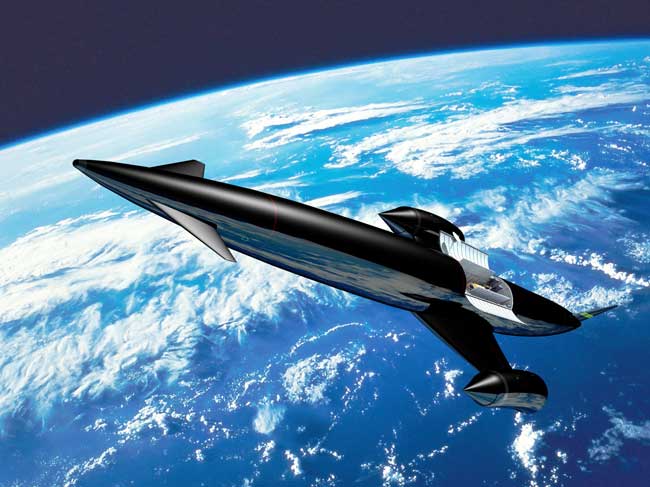British Space Plane Concept Gets Boost

Launching into orbit could become a little easier andcheaper, thanks to a futuristic space plane that looks like it might have flownstraight out of a Star Wars film. ?
The European Space Agency and British government haveawarded $1 million euros ($1.28 million dollars) to Reaction Engines Limited(REL), a British aerospace company, as part of a multi-million dollardevelopment program for an air-breathing rocket engine that could power the Skylonspaceplane. The unpiloted, reusable vehicle is designed to take off from anairstrip, deliver cargo into orbit and return to the same runway.
"This is an example of a Britishcompany developing world beating technology with exciting consequences for thefuture of space," said Lord Paul Drayson, U.K. Minister for Science andInnovation.
A breakthrough could provide relief for space-faringnations, which currently rely on expensive rocket launches that can costthousands of dollars per pound. But the project faces a host of competitors aswell as its own technical challenges.
Breaking down the competition
The Skylon spaceplane would boast a unique SABRE hybridengine which can act as both an air-breathing jet engine and a rocket engine inspace. This gives it a potential advantage over other space plane designs,according to Mark Hempsell, director for Future Programs at Reaction Engines.
Unlike VirginGalactic's SpaceShipTwo or other vehicles designed for suborbital flight, Skylonaims to replace the aging space shuttle, as well as rockets such as Ariane orAres.
Breaking space news, the latest updates on rocket launches, skywatching events and more!
Hempsell noted that a two-stage design such as RocketplaneKistler's falteringK-1 project is possible, but has higher development and operational costs.Scramjets that would channel supersonic airflows appear to be decades off.
As for a purerocket single stage, such as the Lockheed's long-defunct Venturestar design,those are "right on the borderline of feasibility," Hempsell told SPACE.com."I think in reality they are not practical even if possible."
"We have the full advantages of being single stage butwith low technical risk (but admittedly not as low as a two stage),"Hempsell added.
Keep it cool
Unlike most rocket engines, the Skylon's SABRE engine woulduse hydrogen as its fuel rather than as a coolant, and instead would use liquidoxygen for cooling.
That means the air-breathing mode would rely on a revolutionaryheat exchanger pre-cooler, which cools the air that gets compressed and fed tothe rocket engine along with hydrogen fuel. Once the spaceplane enters rocketmode, the hydrogen would be burned along with liquid oxygen.
"We have a working demonstration of the frost controlsystem at flight engine scales, and we have construction of a flight standardheat exchanger module," Hempsell said. That system is slated for testingon a jet-engine-powered rig.
Pressure is on
Skylon would also try to squeeze more power from its engineby using a redesigned exhaust nozzle that makes the most of the space plane?svital fuel.
Ideally, hot exhaust gases should press fully against thewalls of a rocket engine?s nozzles to push a rocket upward and onward, assumingthat the exit pressure matches the atmospheric pressure.
However, current nozzles cannot adjust to differentatmospheric pressures, and only work efficiently at certain altitudes. Exitpressure lower than atmospheric pressure (i.e. low altitudes) means that theescaping gases may not expand fully against the nozzle wall. That means lessthrust for the rocket and more wasted fuel.
By contrast, exit pressure greater than atmospheric pressure(i.e. high altitudes) means the exhaust gases still expand after escaping therocket nozzle — representing wasted fuel spent outside the rocket and loss of potentialthrust.
"In practical terms this places a maximum on the arearatio that may be used on a system that flies from sea level to vacuum,"said Neil Taylor, an aerospace engineer at the University of Bristol in theU.K. He has helped investigate the new nozzle concept for Skylon.
The new nozzle contains a central "plug" thatforces exhaust gas to flow between the plug and outer walls. The escaping gaseseventually separate from the plug and leave a void in between, which shouldprovide a buffer that allows for atmospheric pressure flexibility as the spaceplaneflies to higher altitudes.
But will it fly?
Skylon could realistically see a 10 percent increase incarrying payload, if the new nozzle design pans out. The technology is based aprototype engine called STERN, which managed a stable flow of exhaust gas undermany different atmospheric conditions.
It has even worked with max efficiency at just 116 poundsper square inch (PSI) inside a test chamber, as opposed to the space shuttlemain engine which needs a test chamber pressure of least 2,900 psi.
But there are still hurdles to surmount, researchers said.One such major obstacle is to make sure Skylon?s engines remain cool enough toavoid melting during flight. The STERN prototype fired for just one second to keepit from overheating, Taylor noted, but added that the problem should not be morechallenging than for a regular engine.
As for Hempsell, he envisions a time when customerscan buy a launch on just weeks or days notice. "Currently you have togive years notice," he said.
- New Video - Spaceplane Skylon: A British Ride to Space
- New Show - NewSpace: The Orbital Industrial Revolution
- Video - ESA's eXperimental Vehicle
Jeremy Hsu is science writer based in New York City whose work has appeared in Scientific American, Discovery Magazine, Backchannel, Wired.com and IEEE Spectrum, among others. He joined the Space.com and Live Science teams in 2010 as a Senior Writer and is currently the Editor-in-Chief of Indicate Media. Jeremy studied history and sociology of science at the University of Pennsylvania, and earned a master's degree in journalism from the NYU Science, Health and Environmental Reporting Program. You can find Jeremy's latest project on Twitter.
